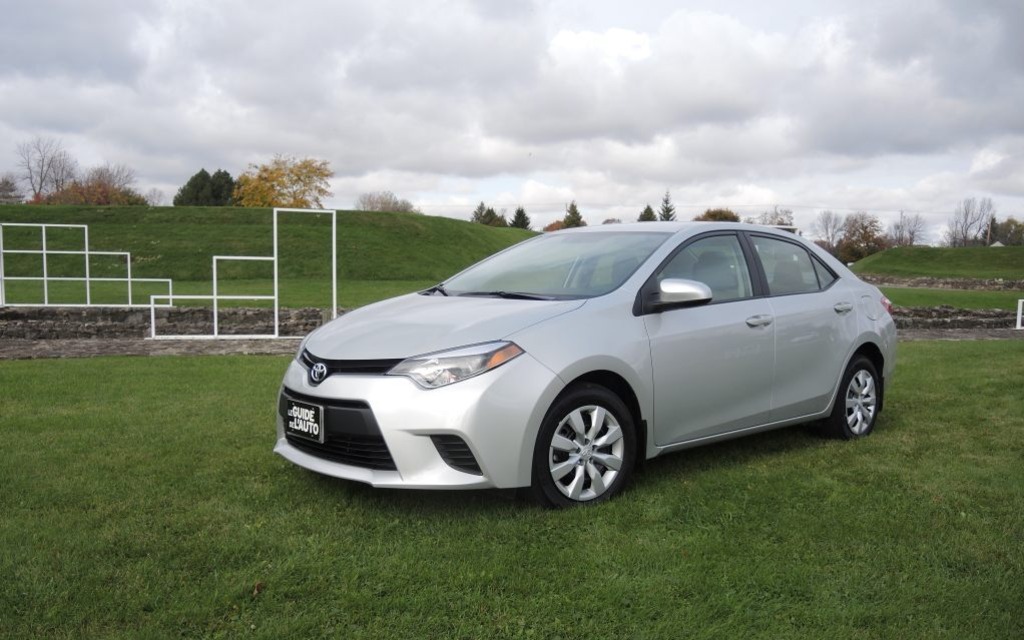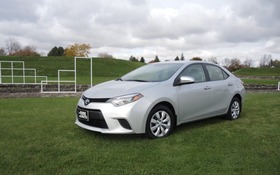2014 Toyota Corolla: New Look, as Sensible as Ever

| Strong points |
|
|---|---|
| Weak points |
|
The new Corolla launched a few months ago, and since Akio Toyoda, top dog at the world’s number one automaker, decreed that the brand’s cars had to have panache, Toyota’s stylists have become bolder – to a certain extent. The Furia concept vehicle introduced in Detroit in January 2013 foreshadowed many of the esthetic changes to the bestselling Toyota in automobile history. With an aggressive front grille, an enormous front air intake, massive wheel wells, taut sheet metal lateral panels, the Furia was promising.
However, those who were expecting an esthetic and mechanical revolution were disappointed when the production model was unveiled. Of course, drastic changes would have been surprising given how popular this car is, especially among buyers whose main priorities are reliability and resale value. Producing a carbon copy of the Furia would have been suicide. Sure, the Corolla would have gained a few new clients, but they would have lost a lot of diehards in the process.
- Also: 2014 Toyota Corolla : Sportier? More Exciting? Less Awkward?
- Also: 2014 Toyota Corolla - Toyota’s Jack of All Trades Gets a Facelift
Having said all that, some advancements have been made, particularly with the LED headlights and large air intake. But when you compare the new Corolla to the latest generations of the Mazda3, Ford Focus and Hyundai Elantra, it’s clear that there’s still progress to be made. On the bright side, the Corolla’s shape is reasonably generic and will have the benefit of aging well.
With respect to size, the car is 100 mm longer overall, as is the wheelbase. The body is 16 mm wider but 6 mm shorter, which gives it a slightly more aggressive look. As a result of these more generous dimensions, the backseats offer more head and elbow room.
Pure practicality
While the body stylists proved to be more creative than usual, the same can’t be said for the dashboard designers. During the filming of the test drive for this car for the Guide de l’auto T.V. show, one of the MAtv technicians found it extremely drab. And he’s right! Sure, they’ve added a few modern touches like buttons on the steering wheel spokes and a centre screen to display important information, but the overall design is something of a throwback to the 1980s.
Still, it’s hard to find fault with the ergonomics, with the buttons situated in all the right places and intuitive to use. The circular gauges are easy to consult and the white numbers on a black background are easy to read. The Corolla also scores high marks for the small information centre located in the lower part of the speedometer. Three large buttons make adjusting the temperature very easy.
There is a decent amount of space in the front seats and on the rear bench, which can seat two adults and a child in reasonable comfort. The trunk has a 383-litre capacity, and the seatback can be lowered to increase the volume. Note that the quality of the materials is good but not extraordinary, while the finish is notably exacting. By the way, the Corolla is manufactured at the Toyota plant in Cambridge, west of Toronto.
Tough but noisy
Toyota engineers are extremely conservative when it comes to choosing the parts for a high-distribution car like the Corolla. There was reason to expect a new engine for the 11th edition, but Toyota decided to play it safe and reliable by keeping the same four-cylinder 1.8-litre 132-hp engine. However, several internal changes were made to reduce fuel consumption. It comes factory standard with a manual gearbox, but there are two optional automatic transmissions available. Surprisingly for a 2014 model, it’s still possible to order a four-speed automatic gearbox on the less expensive trims. The manufacturer seems to have forgotten that this is 2013.
Luckily, you can choose a new CVTi-S transmission that works very well. What’s more, it simulates seven virtual gears that can be selected using the shifter. Speaking of new additions, an Eco version is also available with this 1.8-litre engine, but its Valvematic system helps give it greater valve opening and closing precision, which generates superior power (140 horsepower versus 132) and better fuel economy.
As with the previous edition, there’s a semi-independent torsion beam rear suspension, while there’s an independent strut suspension up front.
Sensible
Looking at this car rationally, it’s hard to find fault. The mechanics and reliability are proven and the handling is good and predictable. True, the front seats could offer more lateral support, but since the traditional buyer of this model is happy just to have a sensible ride, you’ll hear very few complaints. On the manual “S” trim, the pedals are so close together that you get caught on the brake pedal when pressing on the clutch. Moreover, stick shift lacks precision.
As for the LE with CVT, there are no complaints about this drivetrain except that the engine is noisy and it always seems to have to work extra hard to accomplish whatever you ask of it. Fortunately, it’s tough and able to provide decent performance in acceleration and pick-up – the operative word here being “decent.” Driving a Corolla is about as thrilling as opening your refrigerator door: everything works, but you’ll have to get your thrills elsewhere. And you’ll quickly learn the chassis’ limits if you decide to push the car on corners.
Overall, the Toyota Corolla is a sensible, reliable car for those who don’t want any surprises.











